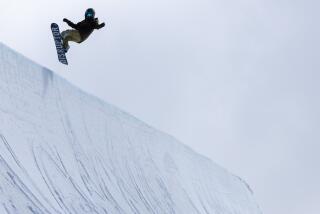Jill Kinmont Boothe is still going strong more than 50 years after paralyzing skiing accident
- Share via
From Bishop, Calif.
Jill Kinmont Boothe is not one to sit idle.
Though the former ski champion, Olympic hopeful and subject of two weepy Hollywood biopics has spent most of her adult life in a wheelchair, she has hardly let it slow her.
A painter and retired schoolteacher, she recently staged her 13th annual in-home Spring Art Show and continues to oversee the Jill Kinmont Indian Education Fund, which provides scholarships to Native American youth in the Eastern Sierra.
“My way of wanting to do all this stuff probably stems a lot from my competitive endeavors because I like to focus on something,” Kinmont Boothe says. “I’m sort of determined.”
That’s putting it mildly.
“I think the thing that impressed me most the first time I met her was that after a few minutes you forgot all about her being in a wheelchair,” says her husband, John. “She obviously isn’t preoccupied by it, and pretty soon you’re not either.”
Kinmont Boothe, 75, wasn’t born to the chair.
In January 1955, the Los Angeles native was the U.S. women’s slalom champion and one of the country’s brightest medal hopes for the 1956 Winter Olympics at Cortina, Italy.
The cover of Sports Illustrated’s Jan. 31, 1955, issue featured a photograph of the fresh-faced 18-year-old, skis slung over her right shoulder and ski poles steady in her left hand.
Inside, a short, gushing story titled “Apple Pie in Sun Valley” noted that while the coaches at a training camp for ski prospects had kept their eyes on the “snub-nosed blonde” because of her Olympic potential, “every other man was watching because she was easily the prettiest girl in the place.”
Her future seemed unlimited.
Three days before the magazine hit newsstands, however, disaster struck: Losing control when she hit an icy bump too fast, Kinmont crashed during a race at Alta, Utah.
She suffered a broken neck and severe spinal cord damage, the accident leaving her a quadriplegic and, in time, the subject of the 1975 film, “The Other Side of the Mountain,” and its 1978 sequel, “The Other Side of the Mountain Part 2.”
Nearly 60 years later, in an interview on the tree-shaded back porch of her home about 45 minutes southeast of Mammoth Lakes, Kinmont Boothe recalls her fateful final run.
“I remember the place I was hurt, I was worried about it before the race,” she says, sipping iced tea. “I felt like I would come into it too fast – and I did. And I remember not understanding why my body felt the way it did – with no feeling, no sensation.”
Three years later, she found herself penning a letter to Roy Campanella, telling the paralyzed ex-Brooklyn Dodgers catcher that being in a wheelchair was “not as bad as it sounded.”
Determined to stay in skiing even if she could no longer ski, she studied German at UCLA. Her ambition was to run a ski shop at Mammoth, where she learned to ski as a youngster after her family moved to Bishop from East Los Angeles.
Before leaving UCLA, however, the would-be shop manager took a part-time job tutoring kids and found her true calling.
“It was a challenge,” Kinmont Boothe says. “Most of the kids really needed help. And between them and me, we could make them understand what they needed to understand.”
Eventually earning her teaching credential at the University of Washington – UCLA denied her admission to its School of Education, she says, because it considered her “unemployable” – the ex-skier taught outside Seattle and in Beverly Hills for a number of years before returning to Bishop in 1975.
What brought her back to her roots was her marriage to Boothe, a Bishop-born truck driver five years her junior.
“I’m a cougar,” she jokes.
She’s also an inspiration.
George Lozito, her former principal, notes that Kinmont Boothe taught the physically challenged and learning disabled in the latter part of her 35-year teaching career.
“It’s a difficult crowd to play to,” Lozito says. “A lot of them had not only learning challenges that they brought to school but all kinds of emotional and social challenges too. Jill was able to address all that in a very quiet, compassionate way. …
“She’s a matriarchal leader.”
Later, when Lozito served as the superintendent of schools for Inyo County, the principal of a new school in Bishop asked him if the students could have a say in naming it. Leery, Lozito said they could submit as many as three proposals.
They submitted only one, and the Jill Kinmont Boothe School sits only a few blocks from its namesake’s home.
In retirement, Kinmont Boothe taught classes there.
“I was a little bit uncomfortable at first,” she notes, smiling. “But it’s very much an honor.”
These days, 15 years after leaving fulltime teaching, Kinmont Boothe devotes much of her time to her painting, mostly watercolors depicting backcountry and high desert landscapes.
Bathed in natural light, she paints in a studio that she and her husband built onto the back of their house.
She sees no reason to dwell on what might have been.
“My life has really been very full,” Kinmont Boothe says. “I’ve had lots of wonderful experiences.”
More to Read
Go beyond the scoreboard
Get the latest on L.A.'s teams in the daily Sports Report newsletter.
You may occasionally receive promotional content from the Los Angeles Times.










